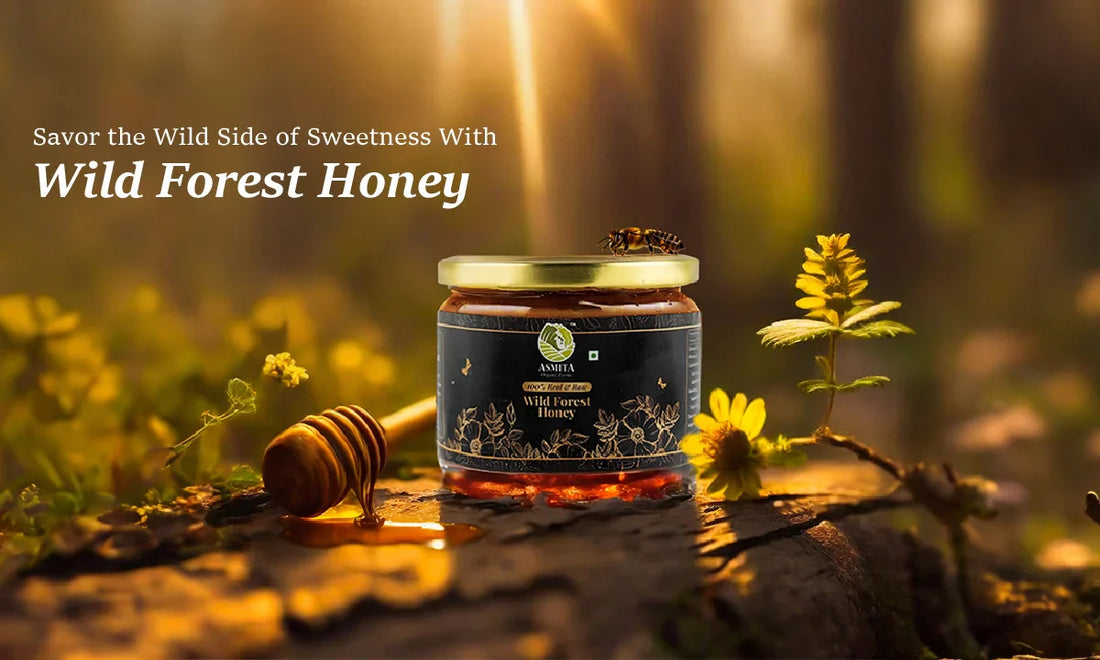5 Reasons Why Wild Forest Honey Reigns Over Regular Honey
Info Organic 5 min read
Do you know that wild forest honey isn't just a sweet treat but a nutritional powerhouse, too? Forest honey surpasses regular honey in terms of health benefits as it is primarily packed with antioxidants, enzymes, and various beneficial compounds. Besides the health benefits, the honey also provides an authentic and pure taste different from regular honey.
It originates from untouched woods and is produced by honey bees in the heart of wild, dense forests. The unique environment gives the honey its distinct taste, unaltered qualities, and added advantages.
Not only does wild forest raw honey differ in flavor, but its appearance also sets it apart from the conventional. Today, we'll explore the distinctive benefits of forest Honey.

Table of Contents
- Benefits of Wild Forest Honey
- Types of Forest Honey
- Wild Forest Honey vs. Regular Honey
- Conclusion
- FAQs
Benefits of Wild Forest Honey

Regular honey is healthy and sweet, but jungle honey is different in an unadulterated and unpasteurized way. Regular honey is different from forest honey when it comes to its benefits, as well.
From treating skin disorders to weight control, the benefits of forest honey are abundant. Here are five reasons and benefits of wild forest honey that make it necessary to incorporate it into your diet:
Antioxidant Power
One of the best benefits of forest honey is that it is full of antioxidants that fight free radicals to keep you happy and healthy. The phytonutrients in wild forest honey give it its potency as an antioxidant and an antibacterial. Antioxidants reduce stress, boost immunity, and support your overall well-being.
Drinking this natural sweetener is like protecting your body against harm, helping you stay strong and thriving. Wild forest honey effectively eliminates all free radicals from our systems because it has a high concentration of antioxidants and nutraceuticals.
Besides all these, one of the key black forest honey benefits is that it strengthens the immune system and lowers the risk of serious illnesses like heart disease.
Floral Fusion
One of the most notable benefits of forest honey is its diverse floral fusion that offers abundant benefits. Wild forest honey, made from various wildflowers, is a burst of flavors. It's not just tasty; it's a mix of nutrients for a balanced diet.
Each drop is like a mini adventure, bringing you the goodness of different flowers in a single, delicious package. That is why it is among the top black Forest honey benefits.
Soothing Inflammation
Wild forest honey is a natural remedy for inflammation. It eases discomfort and helps balance your body. Regularly enjoying this honey treats inflammation at its core, making it a sweet solution for your well-being. Forest honey is important for treating coughs, healing burns, and promoting wound healing.
Happy Gut Helper
Loaded with natural enzymes, another black Forest honey benefits is that it supports digestion and keeps your gut healthy. It helps absorb nutrients, making digestion better.
Including this golden elixir in your routine ensures your stomach stays happy and your digestive system is healthy. Besides this, the prominent black forest honey benefits also include giving a natural and steady energy boost.
Skin and Lip Treatment
The black forest honey benefits for skin are abundant, whereas the benefits of honey for lips are most impressive. Forest honey soaks moisture from the surrounding air and efficiently binds it to the skin, giving it necessary hydration. The skin appears more young and radiant due to the increased hydration, which minimizes the visibility of wrinkles and fine lines.
Honey is a naturally occurring humectant that keeps your lips moistened all day. All these black forest honey benefits make the forest honey stand as a healthier and sweeter option than regular honey.
Types of Forest Honey
The diverse world of forest honey offers a range of flavors, from the light and floral notes of acacia to the robust, earthy tones of pine. Each type of forest honey brings its own unique characteristics. There are different types of forest honey with distinct and delightful taste, which are:
Acacia Honey
Acacia honey, sourced from the delicate blossoms of acacia trees, boasts a light, translucent appearance, and a mild, floral taste. Its low sucrose content makes it a perfect choice for those seeking a sweetener with a subtle flavor profile, making it ideal for drizzling over desserts or adding to tea.
Pine Honey
This honey, harvested from the resinous pine trees, exudes a robust flavor with hints of woody undertones. Rich in antioxidants, pine honey carries potential health benefits. Its amber hue and distinctive taste make it an exceptional addition to both sweet and savory dishes, offering a natural and earthy sweetness.
Eucalyptus Honey
This honey, derived from the nectar of eucalyptus flowers, is characterized by a bold, slightly medicinal flavor. Eucalyptus honey, known for its potential antibacterial properties, is often used to soothe sore throats and coughs. Its dark color and robust taste lend themselves well to pairing with strong cheeses or as a natural remedy for respiratory ailments.
Wildflower Honey
A blend of nectars from various wildflowers, this honey embodies a diverse spectrum of flavors and aromas. Wildflower honey captures the essence of the surrounding flora, ranging from fruity to herbal. Its versatility makes it a go-to choice for culinary applications, such as baking, marinades, and salad dressings, adding a nuanced sweetness to various dishes.
Manuka Honey
Originating from the nectar of the Manuka bush in New Zealand, Manuka honey is renowned for its potent antibacterial properties.
With a rich, caramel-like taste and a dark color, it's prized for its unique flavor and potential health benefits. Often consumed for immune support, Manuka honey is a versatile and distinctive addition to both culinary and wellness routines.
Wild Forest Honey vs. Regular Honey
Wild forest honey and regular honey may seem similar but differ in taste, composition, and benefits. Regular honey, often found in supermarkets, is typically produced by bees that gather nectar from various flowers, including crops. It has a consistent flavor and color due to the diverse floral sources.
On the other hand, wild forest raw honey is harvested by honey bees from the nectar of flowers in natural, untouched forests. It gives it a unique taste, often described as richer and more complex, reflecting the diversity of plant life in the forest.
|
Wild Forest Honey |
Regular Honey |
|
Found and sourced from wild bee hive |
Found in various floral areas |
|
Strong and sweet flavor with a hint of salty notes |
Consistent flavor |
|
Diverse nutrients |
It varies with types |
|
Takes minimal processing |
Takes standard processing |
|
Natural environment needed |
Agricultural environment needed |
In terms of composition, wild flower honey tends to have a higher and more intense concentration of antioxidants and nutrients than regular honey. The diverse plant species in the forest contribute to this nutritional richness, making it a potentially healthier choice.
While both types of honey offer natural sweetness and potential health benefits, choosing between them depends on personal preference and health goals. Some may prefer the consistent taste of regular honey, while others appreciate the unique flavors and potential health advantages of wild forest honey. Regardless of your choice, both can be enjoyed as sweeteners in various dishes or beverages.
Conclusion
Choosing wild forest honey can be a sweet and fitting move for your health. With a richer taste straight from nature, it's not just a sweet treat for your taste buds but also a natural source of goodness. So, next time you reach for honey, consider going wild, which will help you retain good health.
The benefits of forest honey are more than enough for good health. If you want to lead a healthy life by choosing more organic and natural options like forest honey, visit AsmitA Organic Farms, an online organic store offering everything from sweeteners to millets.
Forest Honey - FAQs
01. Why is wild forest honey considered superior to regular honey?
Wild forest honey is sourced from diverse floral varieties in natural ecosystems, providing a richer flavor profile and unique nutritional benefits than honey from monoculture environments.
02. How does the taste of wild forest honey differ from regular honey?
Wild forest honey boasts a complex and diverse flavor profile influenced by the varied plant sources in the forest. This results in a sweeter, more nuanced taste than regular honey's often uniform flavor.
03. What nutritional advantages does wild forest honey offer over regular honey?
Wild forest honey is rich in antioxidants, vitamins, and minerals due to its diverse botanical origin. It provides a broader spectrum of health benefits than regular honey, which may be limited in nutritional content.
04. Why is wild forest honey considered more environmentally sustainable than regular honey?
Harvesting wild forest honey involves minimal human intervention, promoting the preservation of natural ecosystems. In contrast, conventional beekeeping for regular honey may involve monoculture farming practices that can have ecological repercussions.
05. Are there any medicinal benefits specific to wild forest honey?
Yes, wild forest honey is often associated with unique medicinal properties attributed to the diverse plant compounds it contains. These may include anti-inflammatory and antimicrobial effects that can contribute to overall health and well-being.
06. Can wild forest honey help with allergies, similar to regular honey?
While both wild forest honey and regular honey may contain trace amounts of local pollen, there is limited scientific evidence to support the efficacy of honey in alleviating allergies.

